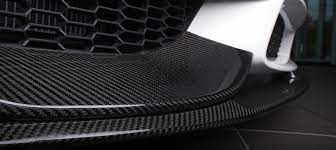Why Carbon Fiber is used in the Manufacturing of Cars

Carbon fiber products are reinventing the world. The strength-to-weight ratio of the composite material Used for the manufacturing process and design in automation, robotics, aerospace, military structures, sports equipment, and many others, carbon fiber has versatile uses across industries. The composite material has a special purpose in the manufacturing of cars and its parts.
Carbon fiber is used in cars for several reasons:
Lightweight: An incredibly lightweight material while still maintaining high strength. Compared to traditional materials like steel, aluminum, or fiberglass, carbon fiber is significantly lighter, which helps improve the overall performance of the vehicle. A lighter car requires less power to accelerate, resulting in improved fuel efficiency and better handling.
Strength and Stiffness: The excellent high strength-to-weight ratio means it is stronger than many other materials while being lighter. It provides excellent structural strength and stiffness, which is crucial for maintaining the integrity of the car’s body and chassis. The stiffness of carbon fiber also helps reduce vibrations and improve the overall driving experience.
Safety: Known for its excellent energy absorption properties. In the event of a crash or collision, carbon fiber composites can absorb and distribute impact forces, helping to protect the occupants of the vehicle. This makes an ideal material for components like crash structures, safety cages, and impact-absorbing panels.
Design Freedom: Carbon fiber composites can be molded into complex shapes and forms, allowing designers to create aerodynamic and visually appealing car components. The flexibility in design enables manufacturers to optimize the vehicle’s aerodynamics, resulting in reduced drag and improved performance.
Corrosion Resistance: Unlike metals, carbon fiber is not susceptible to rust or corrosion. This property makes it ideal for exterior body panels, as well as components exposed to moisture or harsh environmental conditions. Car manufacturers can enhance the durability and longevity of their vehicles.
While carbon fiber offers numerous advantages, it is worth noting that it is generally more expensive than traditional materials. However, with advancements in manufacturing processes and increasing demand, the cost of carbon fiber is gradually decreasing, making it more accessible for automotive applications.
A lightweight, high-strength material that is commonly used in the manufacturing of cars to enhance performance and improve fuel efficiency. Here are some of the carbon fiber products commonly found in cars:
Carbon Fiber Reinforced Polymer (CFRP) Body Panels: Carbon fiber composites are used to make body panels such as hoods, roofs, doors, fenders, and trunk lids. These panels reduce the overall weight of the vehicle while maintaining structural integrity.
Carbon Fiber Monocoque or Chassis: Some high-performance or luxury cars feature a carbon fiber monocoque or chassis. This one-piece structure provides excellent rigidity and strength, improving the car’s handling and safety while reducing weight.
Carbon Fiber Interior Components: Carbon fiber is used for various interior components, including trim pieces, center consoles, dashboard panels, and door panels. These parts add a premium and sporty look to the interior while reducing weight.
Carbon Fiber Suspension Components: Some high-performance cars feature suspension components like control arms, coil springs, and stabilizer bars. The suspension parts offer weight reduction, improved stiffness, and enhanced suspension response and for this carbon fiber components are perfect.
Carbon Fiber Wheels: Increasingly popular in high-performance and supercars. They offer significant weight reduction compared to traditional alloy wheels, leading to improved handling, acceleration, and fuel efficiency.
Carbon Fiber Exhaust Systems: Used in the construction of lightweight exhaust systems, including mufflers and tailpipes. These components not only reduce weight but also enhance the aesthetic appeal and produce a unique sound.
Carbon Fiber Brake Components: The carbon fiber-reinforced ceramic composite materials are often used in high-performance cars. These discs offer excellent heat resistance, reduced weight, and superior braking performance.
Carbon Fiber Aerodynamic Enhancements: Used to create aerodynamic components such as spoilers, splitters, and diffusers. These parts improve downforce, reduce drag, and enhance overall vehicle stability at high speeds.
It’s worth noting that while carbon fiber offers numerous benefits, its high cost limits its widespread use in mainstream car manufacturing. However, as technology advances and production costs decrease, we can expect to see more carbon fiber components in future car models.
NitPro Composites is a carbon fiber composites manufacturer offering products in rods & tubes, sheets, CNC parts, pultruded profiles, etc. for applications in a wide range of industries.
Source by- https://nitprocomposites.blogspot.com/2023/06/why-carbon-fiber-is-used-in.html
